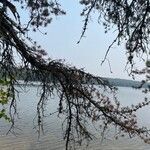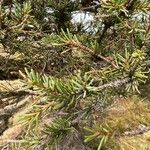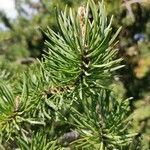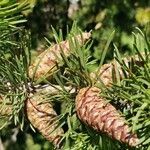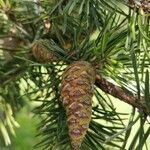Small widespreading, open tree to 10 m high (to c. 16 m in cultivation). Branches very irregular, often curved. Bark rough, greyish on surface, reddish brown beneath, flaking with thick scales and becoming slightly fissured. Shoots greenish to brown or dark brown, glabrous. Buds cylindric or cylindric-ovoid, very resinous, brown with whitish resin; scales appressed. Lvs 2 per fascicle, 1-5 cm × 1.5-2 mm, curved or twisted, lying at different angles to shoot, deep green, rigid and pungent; resin canals marginal; sheath soon very short. ♂ strobili c. 1 cm long, broadly cylindric to subglobose. Conelets sessile; scales shortly mucronate. Mature cones sessile, persistent for many years and usually remaining closed, 2.5-5.5 × 1.7-2.5 cm, narrow-conic to almost oblong when closed, usually curved towards the narrow apex and appearing asymmetric, pale or yellowish brown; apophyses flat or sometimes convex; umbo not armed. Seed wing broadly asymmetric, 0.5-1 cm long.
Trees to 25 m tall; trunk straight or crooked, to 0.6 m d.b.h. in native range; bark orange-or red-brown, scaly; crown irregularly rounded or flat topped; branchlets orange-red or red-brown, aging gray-brown, slender, rough; winter buds red-brown, ovoid, resinous. Needles 2 per bundle, yellow-green, twisted, 2-5 cm × 1-1.5(-2) mm, stomatal lines present on all surfaces, fine, base with semipersistent sheath 3-6 mm, margin finely serrulate. Seed cones upcurved, nearly sessile or shortly pedunculate, tan to pale brown or greenish yellow, ovoid when open, asymmetric, 3-5.5 cm, maturing in 2 years, then soon shedding seeds or often long serotinous and shedding seeds only with age or after fire. Apophyses mostly depressed but increasingly mamillate toward outer part, basal of cone; umbo depressed, sunken centrally, small, unarmed or with a small, reflexed apicula. Seeds brown or nearly black, compressed obovoid, oblique, 4-5 mm; wing 1-1.2 cm.
A tree. It grows to 25 m tall. The trunk is 0.6 m across. The trunk tapers and the crown is cone shaped. The bark is orange or red-brown. It is scaly. The crown can be flat topped or irregularly rounded. The small branches are orange red. There are 2 needles per bundle. They are yellow green and twisted. They are 2-5 cm long by 1-1.5 mm wide. The edges are finely toothed. The seed cones curve upwards. They are pale brown or greenish yellow. They are oval when open. They are unequal in shape. They are 3-5.5 cm long. They then shed seeds but sometimes only with age or fire. The seeds are brown or nearly black and compressed. They are 4-5 mm across.
Usually a small tree, or sometimes to 20 m, with spreading branches; winter buds less than 1 cm, pale cinnamon-brown, very resinous; lvs in 2’s, persisting 2–3 years, usually curved, 2–3.5 cm × 1–1.5 mm; cones erect or nearly so, long-persistent, typically remaining closed for several or many years or until fire, usually curved and asymmetrical, conic, yellowish-brown, 3–5 cm, the apophysis thickened, the umbo not elevated, spineless or with a minute, reflexed spine; seeds ca 1.5 cm. Dry or sterile, sandy or rocky soil; Que. to Me., Vt. and n. N.Y., w. to nw. Ind., Minn., and the Mackenzie Valley.
